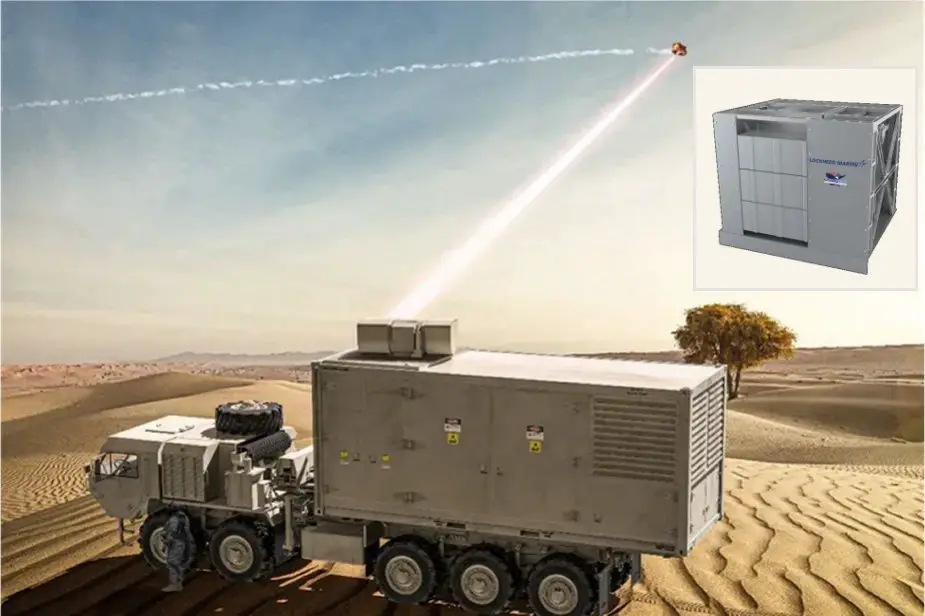Breaking news
Lockheed Martin unveils most powerful Laser Weapon with a 500 kW-class laser.
On July 31, 2023, Lockheed Martin made an announcement about their latest achievement in the development of a 500 kW-class laser weapon, which currently stands as the world's most powerful laser weapon, surpassing their previous 300 kW-class laser. This advancement is a significant milestone within the framework of the High Energy Laser Scaling Initiative (HELSI).
Follow Army Recognition on Google News at this link

Lockheed Martin unveils most powerful Laser Weapon with a 500 kW-class laser (Picture source Lockheed Martin)
HELSI, sponsored by the US Department of Defense, aims to enhance the nation's defense capabilities by advancing high-powered laser weapon systems for all branches of the US military. Lockheed Martin's recent advancement in laser power optimization represents a significant milestone in this ongoing initiative.
The 500 kW-class laser weapon is designed for tactical configurations and incorporates the Department of Defense's Modular Open System Approach standards, which promote system interoperability and multi-mission integration. Lockheed Martin aims to demonstrate the capabilities of this technology to improve protection against various threats and bolster the defense capabilities of the United States Armed Forces.
Other major contractors, including General Atomics, nLight Photonics, Boeing, Northrop Grumman, and Dynetics, are also contributing to the HELSI program. Their collaborative efforts are contributing to the progress of directed energy weapons, potentially impacting modern warfare tactics.
The 300 kW-class High Energy Laser Weapon System (HELWS), previously developed by Lockheed Martin under the HELSI program, showcased the potential of directed energy weapons (DEW) in the US Army's efforts to integrate high-energy laser technology into existing defense systems. The HELWS functioned as a mobile laser system with counter-unmanned aerial system (C-UAS) capability and was part of the US Army's Indirect Fire Protection Capability-High Energy Laser (IFPC-HEL) program.
Lockheed Martin was selected in 2019 to advance its spectral beam combined high-energy laser architecture under an $83 million contract. The successful delivery of the 300 kW-class laser in September 2022 highlighted the advantages of directed energy laser weapons, including lightweight hardware, instantaneous target engagement, reduced logistical requirements, high precision, and limited collateral damage.
Laser weapons operate by utilizing highly concentrated and coherent beams of light to engage and neutralize enemy assets. Their efficiency lies in beam-control optics and sophisticated software algorithms that focus and direct the laser beam toward intended targets. By combining multiple kilowatt fiber lasers, these weapons produce precise and powerful beams, with adjustments made to compensate for atmospheric distortions, ensuring improved accuracy over long distances.
One of the key advantages of laser weapons is their speed of light, enabling near-instantaneous target engagement over extended ranges. This swift response capability potentially offers tactical advantages in combat scenarios, reducing the target's time to react or defend itself.
Moreover, laser weapons are known for their precision and accuracy, significantly minimizing the risk of collateral damage and unintended casualties. In complex and densely populated environments, this precise targeting capability is essential in safeguarding civilians and non-combatants.
The cost-effectiveness of laser weapons is also noteworthy, as their operational expenses primarily revolve around powering the lasers, leading to potential long-term savings for military operations. Additionally, these weapons boast unlimited ammunition capabilities, firing continuously as long as they have sufficient power and cooling.
Laser weapons are broadly categorized into "spectrum beams" and "distributed gain" systems, each finding military applications. Spectrum beams combine multiple individual lasers, while distributed gain lasers project energy serially through slabs. Both types have demonstrated their efficacy in various military contexts.
With diverse applications, laser weapons have the potential to impact defense strategies. They can be employed for anti-missile and anti-aircraft defense systems, countering hostile drones, engaging surface-to-air and surface-to-surface targets, and providing shipboard defense on naval vessels.
Furthermore, laser weapons hold promise for non-lethal applications, including crowd control and disabling vehicles without causing permanent harm. This versatility allows for a wide range of military and defense applications, complementing traditional ballistic weapons and offering advanced tools to address emerging threats.
As laser technology continues to advance, these weapons are expected to play a pivotal role in national security and defense strategies, potentially reshaping modern warfare.


























